Famiglia : Charoniidae

Testo © Dr. Domenico Pacifici
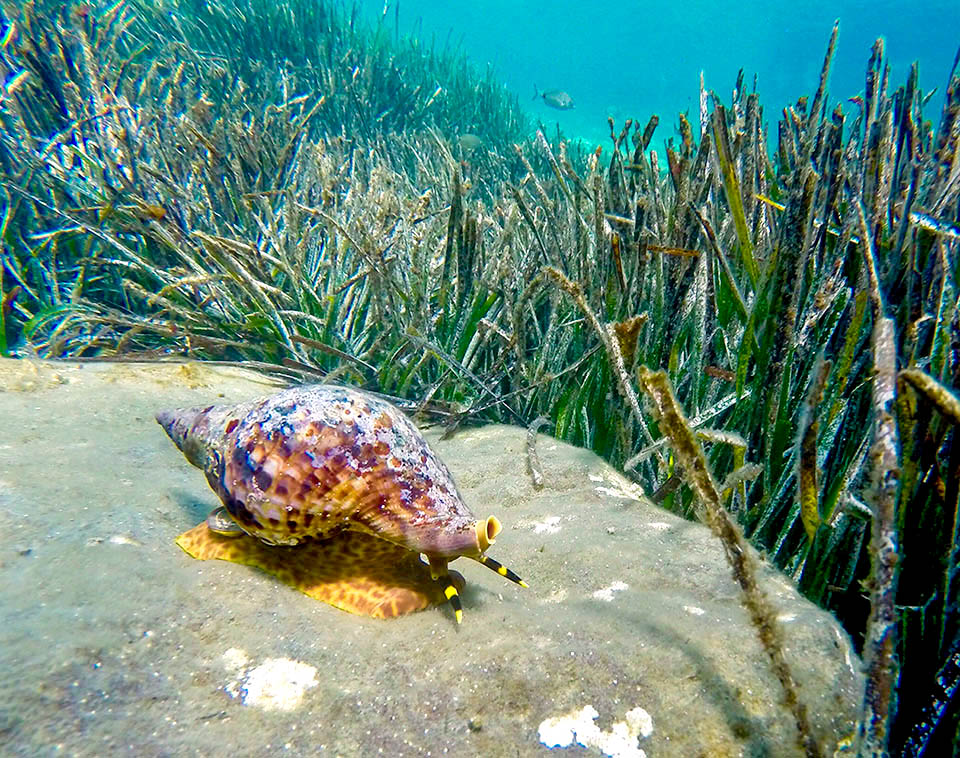
Presente nell’Atlantico, Charonia variegata si trova anche nel Mediterraneo lungo le coste della Grecia e della Turchia © levend
Charonia variegata (Lamarck, 1816) è un mollusco gasteropode marino appartenente alla famiglia Charoniidae.
Questa specie è conosciuta anche con l’evocativo nome di Tritone Atlantico o Tromba di Tritone in onore al figlio del re del mare Poseidone, spesso raffigurato con una conchiglia in mano usata come tromba per calmare le tempeste. In origine, infatti, il nome era Triton variegatum ma fu cambiato in Charonia nel 1969 da Johannes Gistel poiché il termine “Triton” era diventato polisemico, ovvero con molteplici significati.
Il nome del genere Charonia deriva dal nome romano Caronte, in greco antico “Χάρων”, famoso personaggio mitologico che accompagnava le anime dei defunti attraverso lo Stige, il fiume degli inferi. Il nome della specie variegata deriva dal latino “variegatus” = maculato, variegato, in riferimento alla livrea dell’animale.
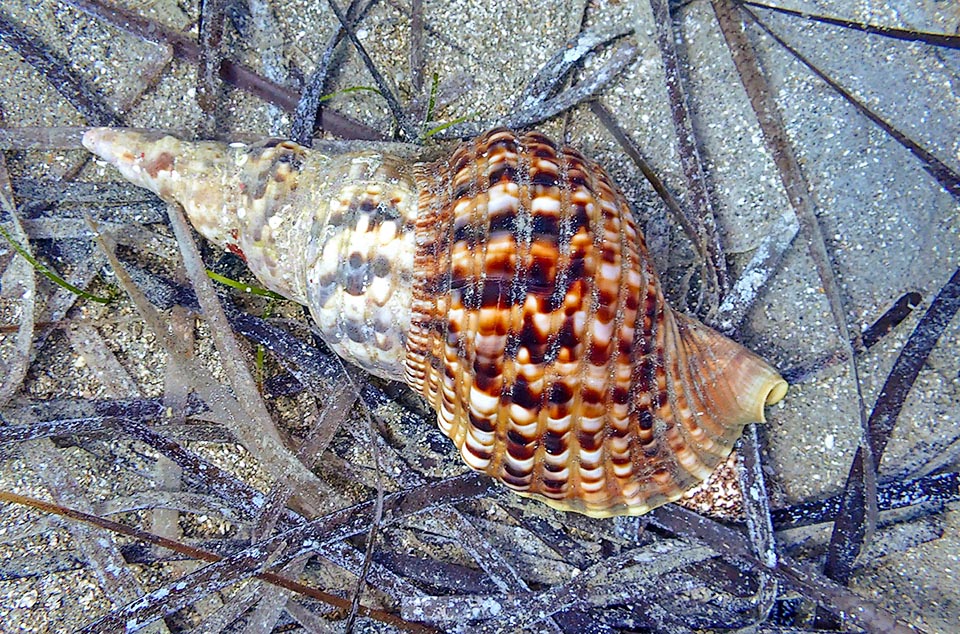
È un mollusco imponente che può raggiungere i 40 cm e si muove in genere sui fondali fra 5 e 20 m di profondità, ma è stato trovato anche a 100 m © Falk Viczian Solarboot-Projekte gGmbH
Zoogeografia
Al genere Charonia appartengono almeno quattro specie, distribuite nei mari temperati e tropicali: Charonia lampas (Linnaeus, 1758), diffusa nelle acque temperate degli oceani Atlantico, Indiano e Pacifico, e nel Mediterraneo occidentale; Charonia marylenae Petuch & Berschauer, 2020, con distribuzione limitata al Brasile meridionale; Charonia tritonis (Linnaeus, 1758), la specie di maggiori dimensioni e con la più ampia distribuzione geografica che si estende attraverso la regione tropicale Indo-Pacifica; Charonia variegata, separata dalla precedente sotto i profili genetico e geografico in seguito al sollevamento dell’istmo di Panama durante il tardo Pliocene (3,3 – 3,0 Ma), e distribuita nell’Oceano Atlantico, dalla Carolina del Nord alle coste del Brasile. È meno comune nell’Atlantico che bagna l’Africa nord-occidentale, le Isole Canarie, Madeira, Capo Verde e Sant’Elena.
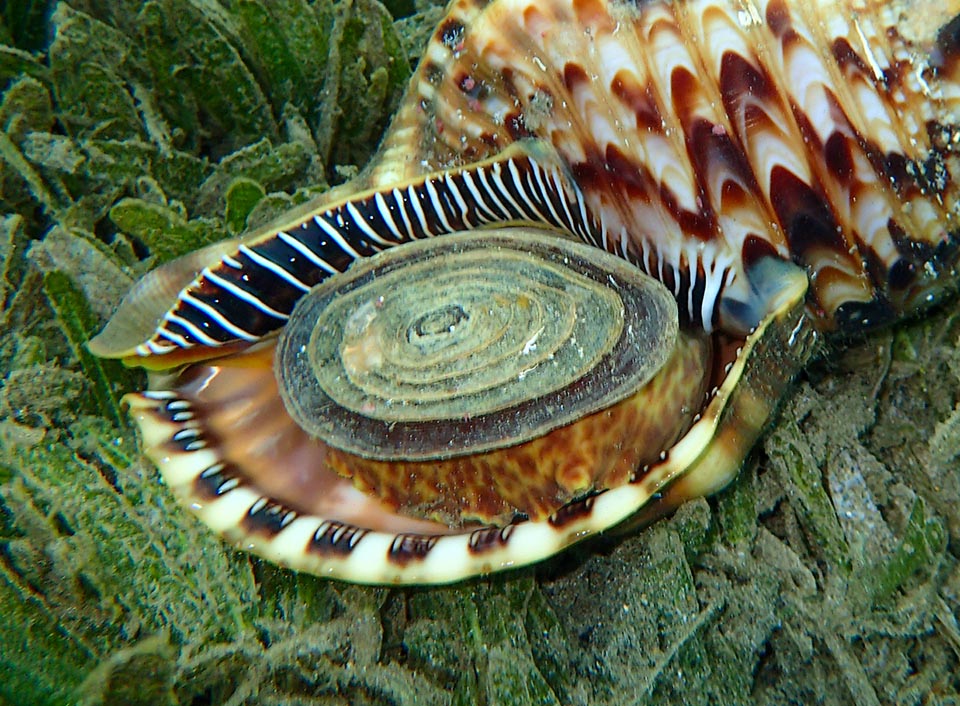
Le spire sono marcate ed irregolari e le labbra dell’opercolo recano bande trasversali bianche a forma di unghia, chiamate denti © Laurent Fey
Nel Mar Mediterraneo questo mollusco ha colonizzato le sponde greche estendendosi lungo tutta la costa della Turchia e di Cipro, sebbene secondo alcuni autori le popolazioni cipriote potrebbero appartenere alla specie Charonia seguenzae (Aradas & Benoit, 1871).
Ecologia-Habitat
Charonia variegata predilige acque poco profonde, con un range batimetrico compreso tra i 5 e i 20 m anche se, in rarissimi casi, sono stati trovati esemplari a più di 100 m di profondità, mostrando l’incredibile adattabilità di questa specie.
La si può trovare nelle praterie di fanerogame, nelle barriere coralline ed in particolare su alghe, massi, coralli, rocce e sabbia.
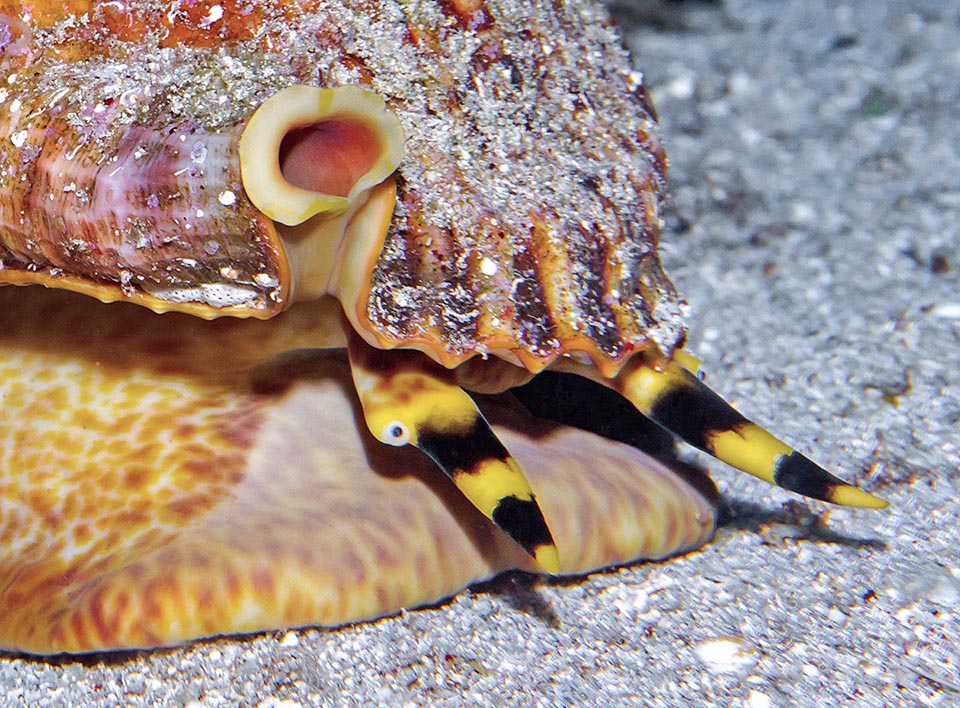
Caratteristici sono i tentacoli gialli a strisce nere con funzione olfattivo-sensoriale. Aiutano gli occhi per la caccia e fiutano l’avvicinarsi di possibili predatori © Brian Cole
È un vorace predatore notturno e si nutre principalmente di echinodermi, cioè ricci e stelle di mare, ma saltuariamente anche di oloturie come i cetrioli di mare.
Cattura la preda fermandola con il possente piede e ne perfora il derma con la radula iniettando una saliva paralizzante e succhiandone la sostanza interna con la radula, la lingua tipica dei gasteropodi.
Per l’ingestione e la digestione della preda sono necessari anche diversi giorni ma in alcuni casi, date le modeste dimensioni, è capace addirittura di ingerire piccoli molluschi interi.
Morfofisiologia
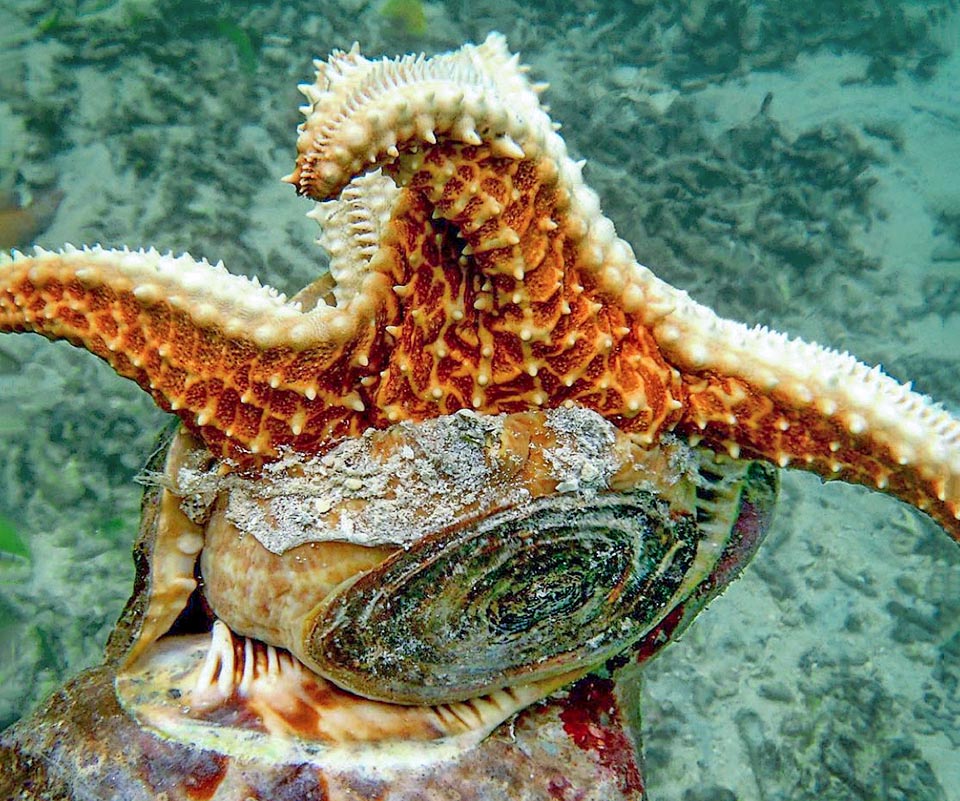
Qui, nei Caraibi, ha bloccato col piede un Oreaster reticulatus. Perforando il derma ha iniettato nella stella marina una saliva paralizzante e ora ne risucchia l’interiore © Brianna Tracy-Sawdey
La conchiglia di questo mollusco è imponente e può arrivare ad una lunghezza massima di 40 cm. Di forma affusolata e con una cuspide appuntita, il guscio ha una colorazione variegata di tonalità che vanno dal bianco crema al marrone scuro e, occasionalmente, arancione o dorato.
Le spire sono marcate ed irregolari e le labbra dell’opercolo sono rivestite da bande trasversali a forma di unghia color bianco, chiamate denti. Il corpo dell’animale è giallo maculato con chiazze color marrone chiaro disseminate per tutto il corpo.
Molto caratteristici i tentacoli di color giallo con strisce nere presenti sul capo, con funzione olfattivo-sensoriale, adibiti alla caccia o alla percezione di predatori nelle vicinanze.
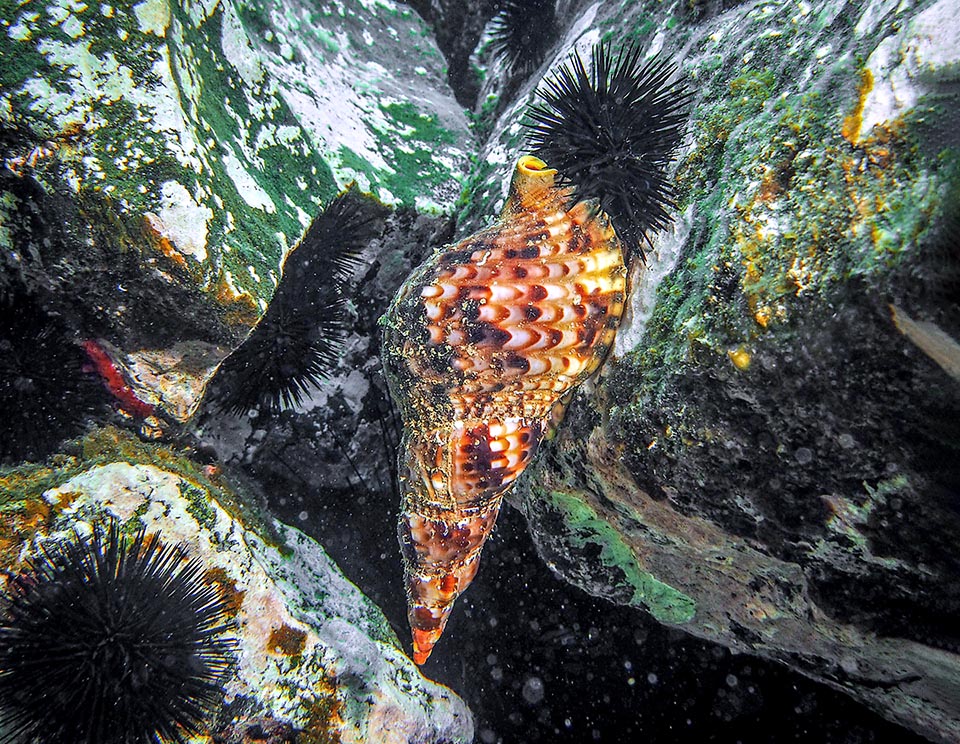
Nel Mediterraneo, in Spagna, la preda di turno è qui un Paracentrotus lividus, riccio di mare molto frequente lungo le coste © Susanne Spindler
Etologia-Biologia Riproduttiva
A differenza di molti molluschi gasteropodi questa specie non è ermafrodita ma ha sessi separati e la riproduzione avviene per fecondazione interna. A fecondazione avvenuta la femmina depone circa un centinaio di uova a forma di goccia attaccandole su una parete rocciosa o una cavità ben riparata. Diversi studi recenti hanno dimostrato come la femmina rimanga in contatto con la sua covata durante tutto il periodo di sviluppo delle uova.
Dopo all’incirca tre o quattro settimane le uova si schiudono rilasciando le larve in acque libere. Le larve hanno uno sviluppo di oltre tre mesi e sono di tipo “veliger”. Questa è una forma larvale tipica dei gasteropodi caratterizzate da un piccolo guscio che circonda gli organi viscerali e da un “velum” ciliato utilizzato per il nuoto e la raccolta del particolato circostante.
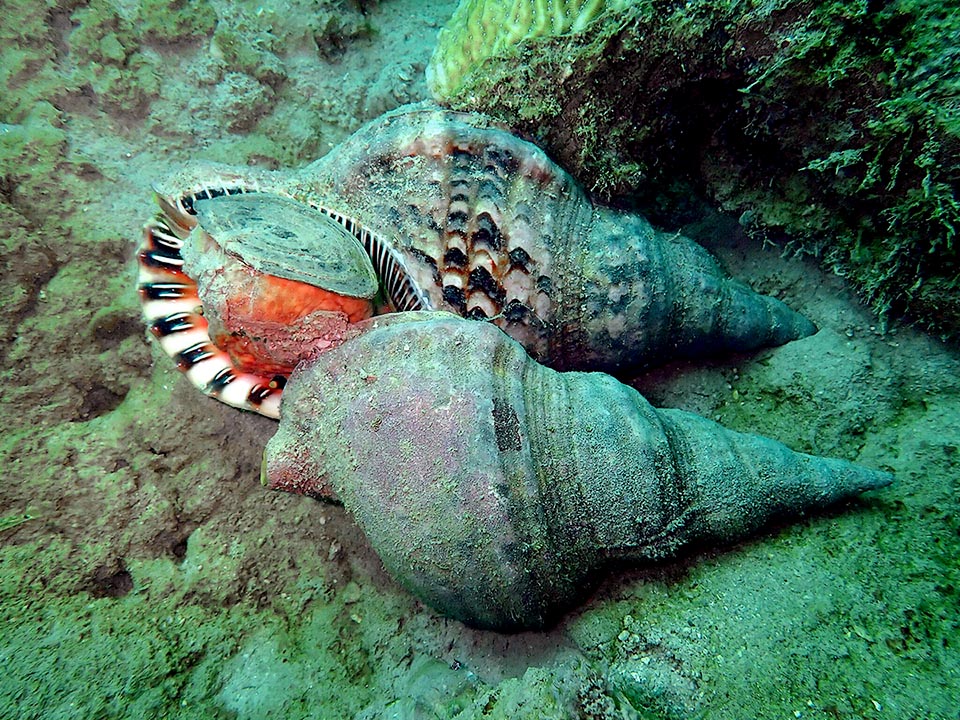
Due esemplari affiancati. L’opercolo si sta alzando e non è certo per predare. A differenza di molti gasteropodi Charonia variegata non è ermafrodita ma ha sessi separati e la riproduzione avviene per fecondazione interna. La femmina depone circa un centinaio di uova a forma di goccia attaccandole su una parete rocciosa o una cavità del fondale © Ben Hutchins
In alcune aree del mondo, come in Guadalupa, Charonia variegata è usata a scopo alimentare e quindi è stata definita una taglia minima di cattura di 25 cm.
Le popolazioni delle specie di Charonia, abbondanti in passato, risultano in declino numerico se non del tutto estinte in molte aree geografiche, soprattutto a causa della raccolta eccessiva. Allo stato attuale, sebbene non presente nella Lista Rossa IUCN, Charonia variegata è comunque protetta dall’Allegato II della Convenzione di Berna del 1979 e dalla Convenzione di Barcellona del 1999.
Sinonimi
Charonia tritonis variegata Lamarck, 1816; Triton variegata Lamarck, 1816; Triton atlantica Bowdich, 1822; Tritonium sulcatum Risso, 1826; Charonia tritonis nobilis Conrad, 1849; Triton nobilis Conrad, 1849; Tritonium commutatum Kobelt, 1876; Tritonium sulcatum Risso, 1826.
→ Per apprezzare la biodiversità dei MOLLUSCHI cliccare qui.
